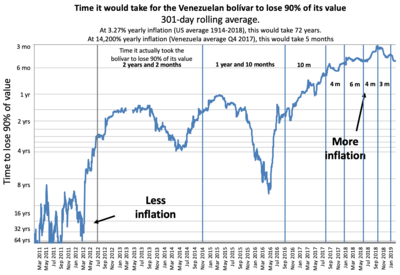

| Part of a series on |
| Economics |
|---|
 |
In economics, hyperinflation is a very high and typically accelerating inflation. It quickly erodes the real value of the local currency, as the prices of all goods increase. This causes people to minimize their holdings in that currency as they usually switch to more stable foreign currencies.[1] Effective capital controls and currency substitution ("dollarization") are the orthodox solutions to ending short-term hyperinflation; however there are significant social and economic costs to these policies.[2] Ineffective implementations of these solutions often exacerbate the situation. Many governments choose to attempt to solve structural issues without resorting to those solutions, with the goal of bringing inflation down slowly while minimizing social costs of further economic shocks.
Unlike low inflation, where the process of rising prices is protracted and not generally noticeable except by studying past market prices, hyperinflation sees a rapid and continuing increase in nominal prices, the nominal cost of goods, and in the supply of currency.[3] Typically, however, the general price level rises even more rapidly than the money supply as people try ridding themselves of the devaluing currency as quickly as possible. As this happens, the real stock of money (i.e., the amount of circulating money divided by the price level) decreases considerably.[4]
Hyperinflation is often associated with some stress to the government budget, such as wars or their aftermath, sociopolitical upheavals, a collapse in aggregate supply or one in export prices, or other crises that make it difficult for the government to collect tax revenue. A sharp decrease in real tax revenue coupled with a strong need to maintain government spending, together with an inability or unwillingness to borrow, can lead a country into hyperinflation.[4]
- ^ O'Sullivan, Arthur; Sheffrin, Steven M. (2003). Economics: Principles in action. Upper Saddle River, New Jersey: Pearson Prentice Hall. pp. 341, 404. ISBN 0-13-063085-3.
- ^ Berg, Andrew; Borensztein, Eduardo (December 2000). "Full Dollarization: The Pros and Cons". International Monetary Fund. Retrieved 26 August 2023.
- ^ Bowyer, Jerry (9 August 2012). "Where's the Hyperinflation?". Forbes. Archived from the original on 2 August 2018.
- ^ a b Bernholz, Peter 2003, chapter 5.3